



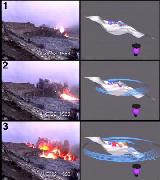 Physical Constraints on Mining Explosions
Physical Constraints on Mining Explosions
Synergy of Seismic and Video Data with Three Dimensional Models
This is the HTML Web page version of a paper prepared for Seismological
Research Letters, Spring 1996. It includes gif and jpeg images as well as mpeg
movies of mining blasts and synthetic computer models.

The following MPEG movies document the SMU/Los Alamos mine blasting experiments in 1995 and 1996 as described in the report titled "Reducing the Ambiguity and Visibility of Seismic Signals from Mining Activities."
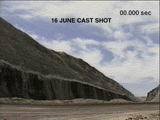 16 June 1995
16 June 1995
This mpeg movie taken from within the pit of the coal mine is of a large
cast blast. Video of the explosion has been deinterlaced and time tagged.
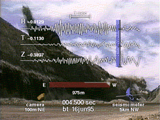 16 June 1995 Waveforms
16 June 1995 Waveforms
Observed ground motions and a model of the blast (turns from white to red at
design shot time) have been superimposed and time correlated with the video
images of the explosion.
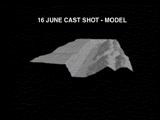 16 June 1995 Model
16 June 1995 Model
A model depicting the generation and propagation of the compressional energy
resulting from the detonation of each of the individual borehole in the 16
June explosion. The design shot times of the explosion were used to create
the visualization.
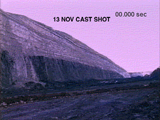 13 November 1995
13 November 1995
This mpeg movie taken from within the pit of the coal mine is of a large
cast blast. Video of the explosion has been deinterlaced and time tagged.
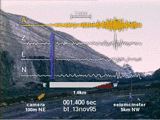 13 November 1995 Waveforms
13 November 1995 Waveforms
Observed ground motions and acoustic wavewforms and a model of the blast
(turns from white to red at design shot time) have been superimposed and
time correlated with the video images of the explosion. Note the large peak
amplitude at late time in the ground motions which is reflective of the
simultaneous detonation of several boreholes towards the end of the shot.
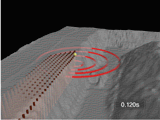 13 November 1995 Model
13 November 1995 Model
A model depicting the generation and propagation of the compressional energy
resulting from the detonation of each of the individual borehole in the 13
Nov explosion. The simultaneous detonation of several boreholes at the end
of the shot is depicted.
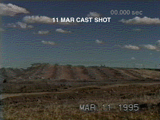 11 March 1995
11 March 1995
This mpeg movie taken from the bench at the end of the pit is of a large
cast blast. Video of the explosion has been deinterlaced and time tagged.
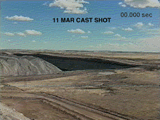 11 March 1995 Spoils
11 March 1995 Spoils
This mpeg movie taken from the spoils pile overlooking the pit is of a large
cast blast. Video of the explosion has been deinterlaced and time tagged.
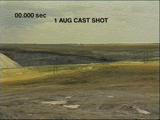 01 August 1996
01 August 1996
This mpeg movie taken from the spoils pile overlooking the pit is of a large
cast blast. Video of the explosion has been deinterlaced and time tagged.
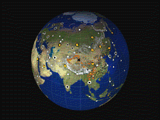 Primary and Auxiliary Seismic Stations
Primary and Auxiliary Seismic Stations
This mpeg movie represents the Primary and Auxiliary seismic stations
proposed as part of the International Monitoring System for the
Comprehensive Test Ban Treaty. As the globe turns the model zooms into a
mine in NE Wyoming where video from a large explosion is played. Explosions
such as this one may produce seismic signals that will be detected by some
of the seismic stations in the International Monitoring System.

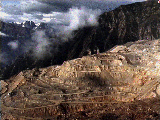 The Tyrnyauz Molybdenum Mine (59k jpeg)
This is one of the largest moly mines in the world, operated continuously for
over 50 years by the former Soviet Union in Tyrnyauz, in the Russian autonomous
republic of Kabardino-Balkaria. In 1993 an
international seismic research team led by Brian W. Stump of SMU
were the first western scientists ever to
instrument and document the blasting practices at the Tyrnyauz mine.
The gif image is 248k.
The Tyrnyauz Molybdenum Mine (59k jpeg)
This is one of the largest moly mines in the world, operated continuously for
over 50 years by the former Soviet Union in Tyrnyauz, in the Russian autonomous
republic of Kabardino-Balkaria. In 1993 an
international seismic research team led by Brian W. Stump of SMU
were the first western scientists ever to
instrument and document the blasting practices at the Tyrnyauz mine.
The gif image is 248k.
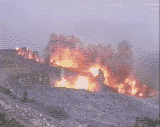 The Tyrnyauz Blast (399k mpeg)
These images document mining practices in a moly mine of the former Soviet
Union in Tyrnyauz, in the Russian autonomous
republic of Kabardino-Balkaria.. This blast used bore holes approximately
12 inches in diameter and 36 feet deep, loaded with ANFO explosive. The
holes were not stemmed (backfilled) and thus produced huge airblasts.
The gif image of the blast is 197k.
The Tyrnyauz Blast (399k mpeg)
These images document mining practices in a moly mine of the former Soviet
Union in Tyrnyauz, in the Russian autonomous
republic of Kabardino-Balkaria.. This blast used bore holes approximately
12 inches in diameter and 36 feet deep, loaded with ANFO explosive. The
holes were not stemmed (backfilled) and thus produced huge airblasts.
The gif image of the blast is 197k.
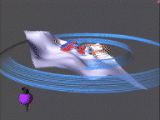 Tyrnyauz Blast Model (395k mpeg)
This model simulates a 500 frames per second slow motion film of the
Tyrnyauz moly mine blast, including the row-by-row delay times and the
sequential firing of the explosive charges.
The blue rings represent the seismic wavefronts moving
out at about 3000 meters per second. The yellow rings represent the
accompanying slower airblasts.
Tyrnyauz Blast Model (395k mpeg)
This model simulates a 500 frames per second slow motion film of the
Tyrnyauz moly mine blast, including the row-by-row delay times and the
sequential firing of the explosive charges.
The blue rings represent the seismic wavefronts moving
out at about 3000 meters per second. The yellow rings represent the
accompanying slower airblasts.

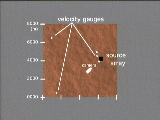 Multi-Shot Experiment (550k mpeg)
American open-pit coal mine blasting. This experiment studied a small 4x4 array
shot which was heavily instrumented both at close range and regional distances.
Velocity gauges and accelerometers as well as velocity-of-detonation (VODR)
recoders and hi-speed film and video cameras were used to form combined
data sets used to quantify seismic source processes. This is not really a
movie, just 6 stills in mpeg format.
Multi-Shot Experiment (550k mpeg)
American open-pit coal mine blasting. This experiment studied a small 4x4 array
shot which was heavily instrumented both at close range and regional distances.
Velocity gauges and accelerometers as well as velocity-of-detonation (VODR)
recoders and hi-speed film and video cameras were used to form combined
data sets used to quantify seismic source processes. This is not really a
movie, just 6 stills in mpeg format.
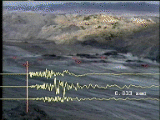 Multi-Shot Blast (470k mpeg)
Digitized video has been de-interlaced and de-jittered to produce half speed
images of the blast. This is then combined with ground motion data collected
from 3-axis accelerometers installed near the camera locations.
Note the coupling (or lack) of the ripple fired charges as they go off in
sequence. Note also how little seismic energy is generated from the
re-impacting of the lofted material.
Multi-Shot Blast (470k mpeg)
Digitized video has been de-interlaced and de-jittered to produce half speed
images of the blast. This is then combined with ground motion data collected
from 3-axis accelerometers installed near the camera locations.
Note the coupling (or lack) of the ripple fired charges as they go off in
sequence. Note also how little seismic energy is generated from the
re-impacting of the lofted material.
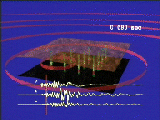 Multi-Shot Model (520k mpeg)
The ground motions and detonation timing are combined in this computer model
of the multiple shot sequence. Three axis ground motion waveforms are dislayed
with a moving cursor for temporal reference. Timing delays deviate from
those designed by the blaster as documented by down-hole VODR and hi-speed
film analysis.
Multi-Shot Model (520k mpeg)
The ground motions and detonation timing are combined in this computer model
of the multiple shot sequence. Three axis ground motion waveforms are dislayed
with a moving cursor for temporal reference. Timing delays deviate from
those designed by the blaster as documented by down-hole VODR and hi-speed
film analysis.
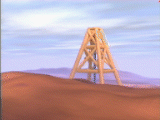 HYDROFRAC (2.19Meg mpeg)
Seismic Verification of Hydraulic Fracture Geometry. This experiment was
performed by the Shell Western Exploration and Production
Bellaire Research Center in Houston, Texas. A single "treatment well" was
surrounded by three "monitor wells" which gathered seismic signals during
the course of the experiment. An hydraulic slurry was pumped under
high pressure to produce a confined fracture at the base of the treatment
well. Seismic data was then analyzed to determine the size and extent of
the fracturing. This visualization models the timing and location of the
seismic events and compares the predicted and actual fracture size, area,
and orientation.
HYDROFRAC (2.19Meg mpeg)
Seismic Verification of Hydraulic Fracture Geometry. This experiment was
performed by the Shell Western Exploration and Production
Bellaire Research Center in Houston, Texas. A single "treatment well" was
surrounded by three "monitor wells" which gathered seismic signals during
the course of the experiment. An hydraulic slurry was pumped under
high pressure to produce a confined fracture at the base of the treatment
well. Seismic data was then analyzed to determine the size and extent of
the fracturing. This visualization models the timing and location of the
seismic events and compares the predicted and actual fracture size, area,
and orientation.

 Source Moment Tensor Estimation of Surface Mining Blasts
Source Moment Tensor Estimation of Surface Mining Blasts
This paper reports the results of a study which characterizes the single mining shot in
terms of its source moment tensor representation. The study uses near-source, broad band
ground motion data collected in a controlled field experiment composed of 8 single-hole surface
mining shot sources. The results reveal characteristics of this particular kind of seismic
source which are useful for understanding the physical source processes involved and
improving our ability to discriminate. This 840k pdf document is a Los Alamos
National Laboratory Technical Report, LA-UR-96-4684.
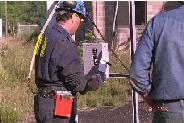 The White Pine Controlled Collapse Experiment
The White Pine Controlled Collapse Experiment
Underground collapses can generate seismic waves that in some
instances are observed at regional (> 1000 km) distances. A physical
understanding of these types of sources may allow them to be distinguished
from other seismic sources such as earthquakes and explosions. This paper
describes results from a near-source and regional seismic monitoring
experiment conducted during an explosively triggered underground mine
collapse. The analysis includes a characterization of the primary collapse
as well as aftershocks that followed the event. This 5.3 megabyte pdf document is a
Los Alamos National Laboratory Technical Report, LAUR-96-2642.
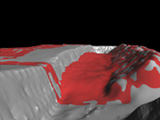 Quantification and Characterization of Regional Seismic Signals from Cast Blasting
in Mines
Quantification and Characterization of Regional Seismic Signals from Cast Blasting
in Mines
Cast blasts in coal mines, designed to move large volumes of
overburden, are a source of large (1-5 kt), frequent explosions in parts of
the world with near-surface coal resources. Mining events of this source
type are triggering the prototype International Monitoring System for the
Comprehensive Test Ban Treaty being tested under the Group of Scientific
Experts Technical Test 3 (GSETT-3). We wish to develop techniques to
distinguish between the seismic signals produced by these explosions and
equivalent size single (or point) sources. To that end, we have developed a
linear elastic model to simulate regional-distance seismograms from mining
cast blasts. This 8.2 megabyte pdf document is a Los Alamos National Laboratory
Technical Report, LAUR-96-3747.
![]() Azimuthal Variation of Radiation of Seismic
Energy from Cast Blasts
Azimuthal Variation of Radiation of Seismic
Energy from Cast Blasts
D.Craig Pearson, Brian W. Stump, Los Alamos National Laboratory,
Robert L. Martin, Thunder Basin Coal Company.
![]() Experimental Study of Seismic Energy Generated by Large
Scale Mine Blasting
Experimental Study of Seismic Energy Generated by Large
Scale Mine Blasting
Robert L. Martin, David Gross, Thunder Basin Coal Company
D.Craig Pearson, Brian W. Stump, Los Alamos National Laboratory
David P. Anderson, Southern Methodist University
![]() Regional Observations of Mining Blasts by the GSETT-3 Seismic Monitoring System
Regional Observations of Mining Blasts by the GSETT-3 Seismic Monitoring System
Brian W. Stump, D.Craig Pearson, Los Alamos National Laboratory

![]() SMU Geological Sciences
Archive
SMU Geological Sciences
Archive
